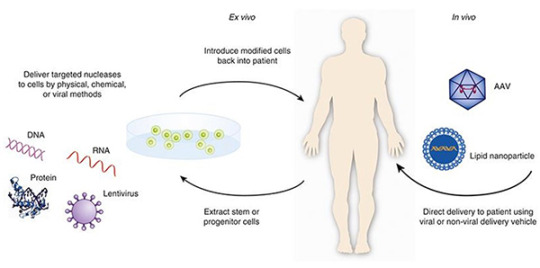#Therapeutic Vectors
Explore tagged Tumblr posts
Text
Lentiviral Vectors: An Advanced Gene Therapy Tool

Lentiviruses are a subgroup of retroviruses known for their ability to infect non-dividing cells. They are enveloped viruses that carry two copies of positive-sense single-stranded RNA as their genetic material. Some notable lentiviruses include HIV, FIV (feline immunodeficiency virus), and SIV (simian immunodeficiency virus). Lentiviruses have the capacity to establish lifelong persistent infections in cells by integrating their genetic material into the host cell's genome. This unique ability makes lentiviruses attractive vehicles for gene therapy applications. Development of Lentivectors In the early 1990s, scientists began developing Lentivectors by removing lentiviral Vectors genes that causes disease while keeping the genes necessary for infection, integration, and transcription. This allowed lentiviruses to serve as a tool to effectively deliver therapeutic genes into both dividing and non-dividing cells without causing an immune response or pathogenesis. Over the years, Lentivectors systems became highly optimized in terms of safety, production efficiency, and target cell transduction ability. Today, lentiviral vectors are widely utilized for conducting gene therapy experiments both in vitro and in vivo. Key Features of Lentiviral Vectors - Ability to stably integrate therapeutic genes into the host cell genome providing long-term gene expression. - Broad tropism allowing transduction of dividing and non-dividing cells such as stem cells, neurons, hepatocytes etc. - High transduction efficiency permitting transgene expression levels sufficient for therapeutic effects. - Minimal immunogenicity owing to the removal of virulence genes. - Packaging capacity of 8-10 kb allowing delivery of large genes. Applications in Gene Therapy Lentiviral vectors hold tremendous potential for treating both inherited and acquired diseases. Some notable applications include: - Hematopoietic stem cell gene therapy for blood disorders like β-thalassemia and sickle cell anemia. - Neurological gene therapy for treating Parkinson's, Alzheimer's, and other neurodegenerative disorders. - Gene therapy for retinal degenerative diseases causing blindness like retinitis pigmentosa. - Editing genes in immune cells for developing "living drugs" against cancer. - Delivering therapeutic genes directly into tumors for cancer gene therapy. Safety Considerations While Lentivectors are considered safer than other viral vectors, certain safety aspects need attention including: - Potential for insertional mutagenesis and oncogene activation due to random vector integration. However, this risk is considered low. - Possible transmission of residual wild-type lentiviral sequences in vector preparations posing as biosafety hazard. However, advanced production methods offer highly purified vectors. - Developing strategies to restrict vector tropism to desired target cells and prevent genotoxic effects. Tissue-specific and inducible promoters help address this issue. Lentiviral vectors have emerged as a versatile and advanced tool for delivering therapeutic genes in vivo. Their ability to transduce non-dividing cells makes them well-suited for treating challenging diseases. Continuous improvements in vector safety, production, and targeting hold promise to leverage lentiviral gene therapy for wider clinical applications. With prudent research, Lentivectors may become a mainstream platform for delivering curative gene-based medicines.
Get More Insights On, Lentiviral Vectors
For More Insights Discover the Report In language that Resonates with you
French
German
Italian
Russian
Japanese
Chinese
Korean
Portuguese
About Author:
Vaagisha brings over three years of expertise as a content editor in the market research domain. Originally a creative writer, she discovered her passion for editing, combining her flair for writing with a meticulous eye for detail. Her ability to craft and refine compelling content makes her an invaluable asset in delivering polished and engaging write-ups.(LinkedIn: https://www.linkedin.com/in/vaagisha-singh-8080b91)
#Lentiviral Vectors#Gene Therapy#Biomedical Research#Molecular Biology#Biotechnology#Therapeutic Vectors
0 notes
Note
So in all these years of the were teen virus, has there ever been a cure or do the transformers enjoy it too much to care? Looks like they all have fun.
Bro, I had to grind a bit and stumbled on some stuff in a med book. It’s a real mission to read, man:
Seasonal Pubertal Regression (Regressio Pubertatis Temporalis): A Novel Syndrome
Abstract
Seasonal Pubertal Regression (SPR), also known colloquially as "Werteenager Syndrome," is an unusual, episodic condition characterized by the sudden reversion of adult patients to a hypersexualized, pubertal state during weekends. The condition exhibits a consistent temporal pattern, is suspected to have a viral etiology, and has profound physiological and behavioral implications. This paper outlines the clinical features, transmission mechanisms, potential pathophysiology, and observed complications of this emerging syndrome.
Clinical Features
SPR manifests as a dramatic transformation occurring primarily in adults with no prior history of endocrinological disorders. The onset of symptoms begins Friday morning with subtle prodromal signs, including excessive axillary hair growth and pronounced morning erections in male patients. By Friday evening, approximately one hour before sunset, the transformation is complete. During this period, patients exhibit:
Physiological Changes:
Rapid development of body hair, particularly on the chest and axillary regions.
Increased androgen levels, inferred from the heightened libido and secondary sexual characteristics.
Behavioral Changes:
Regression to adolescent-like language and interests, often mirroring the cognitive and emotional behavior of high school students with low academic performance.
Predominantly homosexual behavior, with a smaller subset displaying bisexual tendencies.
Compulsive sexual activity, often with multiple partners.
The transformation reverts spontaneously by Sunday evening, approximately one hour after sunset. However, in rare cases, a permanent adolescent state, termed Persistent Pubertal Regression (PPR), has been observed.
Transmission
SPR is presumed to be an infectious disease, transmitted through:
Sexual Contact: The primary route of infection, as evidenced by the sexual hyperactivity of patients during symptomatic episodes.
Body Fluids: Saliva, blood, and other bodily secretions are likely vectors.
Droplet Transmission: Close contact during symptomatic periods is hypothesized to contribute to the spread.
Epidemiological studies reveal a clustering of cases in densely populated areas with high rates of casual sexual encounters.
Pathophysiology
The precise mechanism remains unclear. However, the following factors are hypothesized:
Solar Influence: The timing of transformations suggests a strong correlation with circadian rhythms and solar positioning. This aligns with the hypothesis of a photoresponsive trigger.
Hormonal Dysregulation: An abrupt surge in androgenic and possibly estrogenic activity drives the secondary sexual characteristics and behavioral changes.
Neurological Impact: The regression in cognitive and linguistic abilities points to temporary, reversible alterations in neurochemical pathways.
Complications
One documented case of PPR provides insight into the potential severity of SPR. A pair of patients engaged in reciprocal oral-genital contact ("69" position) during the Sunday evening transition period. Both individuals retained their adolescent state indefinitely. This rare complication underscores the need for further study into the temporal dynamics of SPR.
Management and Future Directions
No effective treatments for SPR currently exist. Research priorities include:
Identification of the Pathogen: Advanced virological studies are needed to isolate the causative agent.
Therapeutic Interventions: Hormonal modulation and phototherapy are potential avenues for investigation.
Behavioral Support: Counseling and harm reduction strategies should be implemented to mitigate the social and psychological impacts on patients and their contacts.
Conclusion
SPR represents a unique intersection of infectious disease, endocrinology, and behavioral science. Its distinct clinical presentation, temporal predictability, and social implications warrant immediate scientific attention. Understanding this condition could provide novel insights into human physiology and the interplay between environment and health.
Dude, so I did some digging and found out about these two bros who were, like, getting down in the 69 position. One dude was this 42-year-old McDonald's branch manager, kind of hefty. Bet he caught it from a weekend warrior coworker. The other guy's a 56-year-old trucker who picked up a hitchhiker with the bad vibes. Now they're both chilling as juniors at a sports college in Minnesota.

Got booted from the Olympic swim team 'cause they wouldn’t shave their chest hair. But no sweat, they’re still legends at the local pool, doing lifeguard duty.
70 notes
·
View notes
Note
Hello,
In your "practice sorcery in a not soul-sucking way" post, you mention a beginner artist doodling a landscape then saying their art "doesn't work".
I was wondering if you have a spell for warding a space against unwanted attention/negative energies, which was the magical equivalent of "paint or scribble until the whole page is black"?
No particular skill necessary, just something blunt and brute-force which may take a lot of energy (SCRIBBLING AS GARD AS YOU CAN AAAA) but which would be cathartic? It's my first spell since.... Playing around initiating a wand with my friend when we were kids. Wow.
The thought of trying to learn correspondences or something is.... Exhausting-sounding. I just need a space that's mine. Maybe with a "keep this space calm and quiet" element thrown in.... And something with knot-tying that leaves me with a charm I can hang, maybe?
If this is too much/too specific, feel free to disregard (though I'd appreciate knowing you got the ask). Thank you so much for your time, and I hope things are going well for you. Also, your chicken-frying spirit-trappjng pot is gorgeous.
Good morning, or it will be in 20 minutes when midnight rolls over.
We are in reference to this post about practicing sorcery, and also this post about my pot of many uses.
Yes I imagine there is probably a short answer but you've given me the chance to talk about theory, so :)
Knot-tying magic is nice and easy, and I really think it doesn't require special skills beyond tying knots. I have this old post about making a simple hanging charm with macrame.
One thing that helps me with the idea of knot magic is that you're always going to be binding something.
You can go with the idea that you are binding up statements of intent which then become like the rungs on a ladder, allowing other energies and intents to climb up into reality.
But I imagine more commonly, you bind things up to trap them (and perhaps releasing them for use later).
This provides a decent idea for part B of your spell, "keep this space calm and quiet." A nice knot tied up by the door to capture disruptions and bind them up and make them inert might suffice.
As for your part A, warding against unwanted attentions and negative energies - you've got options.
And a good place to start is that you want a space that's yours.
I am a huge believer in the efficacy of spiritual authority. Crudely put, there is actual magical power in saying, "this is my space. I own it. Only things I invite inside are allowed."
I don't mean that it's personally powerful, or therapeutic, although it may be those things. I mean that I believe it literally changes something in the record books of the Otherworlds.
Of course it immediately gets more complicated, especially in cases of territory disputes, but by and large a powerful first step for making a space feel safe, comfortable, and barred from unwanted attention and negative energies,
is to magically announce that the space is yours, you are its keeper, and from that point on you call the shots.
Perhaps best of all, doing so requires no correspondences. Just go around and start telling the world how it's going to be. Start with the doorway, and pay due respects to windows and vents. Not because they're vectors of negative energy contamination, but because thresholds are their own species of Creature and know a little bit more than some of the baser household construction.
Put on some music or whatever to get yourself in the state of mind to take it all seriously, and then go to the main entrance and say, "hello; let me introduce myself formally." (And then introduce yourself). "I'd like to let you know I'm going to be responsible for this space from now on. I'm the keeper of this room, and it's on me to decide what comes and goes - not other people in the household."
And then go about to all the various things in the room (for some reason I guess I decided this is for your bedroom) and let them all know that this is your space and you're taking the reins. "Rug by the door, I love the pattern you've got going on. Just to let you know-"
Draw a finger over the wall. That's your wall; the space within it is your space. Touch the window frame and the door frame; they frame only what you allow to pass through, and nothing else. Touch your old things and dig deep through layers of the past: speak the new truth to stacks of things that have been peacefully slumbering for years.
Just go around and have a nice time with it, and in general claim your space. That will set you up pretty well for whatever kind of work you'd like to do next.
The reason I recommend all these big paragraphs of things is because I think it fits the bill of what you're looking for, re. not requiring extra skills.
But then once you've got the room on board and you're set up as the new captain, you might well like to ask the door to keep out intruders. And you should; let the door know your vision of the room moving forward is that nobody but you tries to come into it.
And while you're at it, you might as well give your door a garotte to strangle anyone who tries to come in.
Or.... strangle the energy of intrusiveness in general, you know.
With the knot spell that we were talking about earlier!
If you prepare something nice and simple, like a macrame crystal net, or even a simple overhand knot in some cord, position this by the entryway so that the charm works in tandem with the door (who, remember, is now on your side but could possibly do with reinforcements).
(By the way, a decent way to 'cast' a knot spell is to take some cord and prepare a loose knot and wait for the irritating thing to happen; at the moment it happens, quickly yank the knot closed, and tell the cord, "see? That's exactly the thing I'm talking about, I've just given you an example to work from. You go ahead and bind up the rest now, just like that." Give the cord another knot that's not completely tightened, to let it do the rest itself.)
Besides getting the doors and windows on your side, and tying up intruders, I think you may especially enjoy a nice dish of salt. That link is to @aesethewitch who made a lovely writeup on the idea of ambient spells, and I think this may be just your thing.
I think technically it could be a nice dish of anything, but I think salt probably fits the bill. It's very cheap if you need to buy any, but more importantly, it's got an excellent "filtration" effect that helps to keep a space free of bad vibes.
As far as the political landscape of the room, such a dish of salt could hypothetically be placed anywhere, unlike the sneaky cord of binding, which probably ought to be right next to the door so it can pounce at first sight of an interloper.
69 notes
·
View notes
Text









XX Legion Voss pattern Lightning Strike Fighter 'Alpha-Vector'
It has probably been the longest I've spent on a model in a long time. This has been a little therapeutic too. I've quite enjoyed making an aircraft again, the Voss-pattern Lightning Strike Fighter has been one of my favourites for some time and I've been meaning to get another for one of my armies.
I wanted to try something different with this though, so it is a little bit of a diorama with the Alpha Legion infiltrators on its base, directing forces and calling in airstrikes on centres of opposition.
#warhammer#warhammer 40k#warhammer 40000#w40k#40k#warhammer 30k#warhammer 30000#legiones astartes#30k#w30k#alpha legion#xx legion#voss-pattern lightning strike fighter#lightning strike fighter#voss
25 notes
·
View notes
Text
Immunoblotting of ACE2 as well as S and S-related proteins in HEK293(S + ACE2) cells treated with quercetin. (A) Diagrammatic representation of the S-GFP fusion protein and its proteolytic fragment. Acronyms: NTD, N-terminal domain; RBD, receptor binding domain; FP, fusion peptide; HR, heptad region, TM, transmembrane domain, GFP, green fluorescent protein. (B) Representative Immunoblot of cells extracts transfected with empty vector (EV) (lane 1), vector for expression of S-GFP (lane 8), ACE2 (lane 9), or both S-GFP and ACE2 (lanes 2–7) with DMSO (lane 2) or increasing concentrations of quercetin (lanes 3–7); (a) The blot was immuno-probed successively for GFP and β-actin; (b) a parallel blot of the same cell extracts was immune-probed successively for ACE2 and β-actin antibody. (C) Densitometry of immunoreactive bands in three separate experiments was conducted. S, S2 and S2’and ACE2 values were normalized by those of β-actin (a-c, f). The ratios S2/S (d) and S2’/S2 (e) were computed as measures of the proteolytic conversion S to S2 and S2 to S2’, respectively. Values are expressed as means ± SD. * < 0.05, ** < 0.005
The more I research Quercetin and its therapeutic benefits in preventing/treating COVID and Spike Protein injury/disease, the more I am convinced that it absolutely should have been used across the board from the very beginning. There are some very specific therapeutic benefits from using Quercetin which should have been shouted from the rooftops once they were discovered. Unfortunately, we are not surprised this did not occur.
First, let’s go back to 2020. In November of that year, it was already apparent that Quercetin was almost certainly able to inhibit the SARS-CoV-2 furin enzyme and the Spike Protein.
4 notes
·
View notes
Text
Revolutionizing Healthcare: The Marvels of Gene Therapy
Gene therapy, a cutting-edge medical technique, has emerged as a game-changer in the field of healthcare. This transformative approach involves the modification of a patient's genetic material to treat or prevent a range of diseases. Let's embark on an in-depth exploration of the technical intricacies of this revolutionary treatment, its historical evolution, and its profound implications for the future of medicine.
Gene Therapy in a Nutshell:
Gene therapy primarily operates by introducing, altering, or repairing specific genes within an individual's cells. By utilizing viral vectors, such as adeno-associated viruses (AAVs) or lentiviruses, scientists can deliver therapeutic genes into target cells with remarkable precision, thus opening up new avenues for combating previously untreatable conditions. This precision is akin to the delicate strokes of an artist's brush, where each modification holds the potential to transform lives.
Historical Evolution:
To truly appreciate the significance of gene therapy, it's essential to glance back at its historical evolution. The concept of manipulating genes to treat diseases has been a dream of scientists for decades. The initial steps in gene therapy research were taken in the 1970s and 1980s, but it wasn't until the 1990s that the first clinical trials began, marking a pivotal moment in medical history. Over the years, the field has witnessed remarkable advancements, from developing safer delivery mechanisms to expanding the range of treatable diseases. Today, we stand on the shoulders of these pioneers, poised to achieve what was once thought impossible.
Applications and Achievements:
Gene therapy has already demonstrated remarkable success in treating a wide array of genetic disorders. Conditions like spinal muscular atrophy (SMA), hemophilia, and inherited retinal diseases that were once considered incurable are now within the realm of possibility for effective treatment. Moreover, the revolutionary field of cancer immunotherapy, a subset of gene therapy, harnesses the immune system's power by genetically modifying T cells to specifically target and destroy cancer cells, offering renewed hope to cancer patients worldwide. Excitingly, ongoing research is exploring the potential of gene therapy to combat neurodegenerative diseases, including Alzheimer's and Parkinson's, promising a brighter future for those affected by these devastating conditions. The horizon of possibilities in gene therapy continues to expand, unveiling new hope for patients and their families.
Challenges and Ethical Considerations:
While gene therapy holds immense promise, it is not without its set of challenges and ethical dilemmas. Concerns about off-target effects and immune responses necessitate meticulous research and testing to ensure the safety and efficacy of gene therapies. Ethical discussions surrounding germline editing, the potential for unintended consequences, and the need for responsible genetic manipulation are ongoing, highlighting the importance of a balanced approach to this groundbreaking technology. These discussions underscore the critical need for transparent and collaborative decision-making as we tread carefully in this uncharted territory.
Gene therapy's potential to revolutionize medicine is undeniable. As research continues to advance and ethical considerations evolve, we find ourselves at the threshold of a new era in healthcare. Stay informed and engaged as we navigate this exciting frontier, where science fiction becomes science fact, and hope is restored for countless individuals and families around the world. The future of healthcare has never looked brighter, thanks to the marvels of gene therapy, and it's a future that holds the promise of healthier, happier lives for generations to come.
References:
Kaeppel, C., & Verma, I. M. (2018). Viral Vectors for Gene Therapies: The Road Ahead. Molecular Therapy, 26(3), 699-700. doi:10.1016/j.ymthe.2018.01.011
Rinaldi, C., & Wood, M. J. (2018). Antisense oligonucleotides: the next frontier for treatment of neurological disorders. Nature Reviews Neurology, 14(1), 9-21. doi:10.1038/nrneurol.2017.148
Cyranoski, D. (2019). The CRISPR-baby scandal: what’s next for human gene-editing. Nature, 566(7745), 440-442. doi:10.1038/d41586-019-00550-9

#science#biology#college#education#student#school#medicine#doctors#health#healthcare#gene therapy#genetic engineering#genetics#gene regular show
31 notes
·
View notes
Text
Note Cards (August 2023)
1/3 Upper Shaft of Fibula [Diagram]
1st Cuneiform Facet Shape
2nd Cuneiform Facet Shape
5' Untranslated Region
Acetyl-CoA Production Coenzymes
Adductor Magnus OIA
ampR
Amylopectin
Ancient Society
Antigenic Variation
Apomixis
Ardipithecus
Basal Nuclei
Biceps Femoris OIA
ciso-
Cutaneous Cervical Plexus Branches
Displacement
Functions of Epithalamus
Fusion Protein
Gel Shift Assay
-genic
Helical Wheel
Karabo Skull
Linea Supracondylaris Medialis Femoris
Meninges
Methionine
-metry
Microfilament Functions
Molecules in Human Cells
Nerve Plexus
P. remota Leaves
Plasmid Vector
Polypeptide Terminology
Reticular Dermis
Splitter vs Lumper
T
Tabby
Ternifine 2-3 Bone
Therapeutic Index
Thoracis of Longissimus OIA
Types of Skin Appendages
Use of Aminoglycosides
Welsh Pony of Cob Type
X-Linked Agammaglobulinemia
Zygomatic - Medial View
#studyblr#notes#studying#masterlist#study masterlist#master list#study master list#studyblr resources#study resources#learning#learning resources#school#school resources#free learning#science#academics#academia#learning science#mcat resources#mcat notes#mcat studyblr#mcat masterlist#resource masterlist#scienceblr#medblr#archaeology#anthropology#biology#human biology#bio
3 notes
·
View notes
Text
The Impact of Gene Therapy on Modern Medicine

Gene therapy is a groundbreaking approach in medical science. It offers hope to many patients suffering from genetic disorders and other diseases. The aim of gene therapy is to provide long-lasting and potentially curative treatments by targeting the root cause of these ailments at the genetic level. This approach highlights a significant transformative impact on modern medicine.
Gene therapy involves introducing, altering, or removing genes within an individual's cells to treat or prevent disease. The two primary types are somatic gene therapy, which targets nonreproductive cells, and germline gene therapy, which affects reproductive cells and can be passed on to future generations. Techniques such as viral vectors, which deliver new genes to cells, and CRISPR-Cas9, a precise gene-editing tool, have revolutionized this field, enabling more accurate and efficient genetic modifications.
The journey of gene therapy began in the early 1970s with foundational research that paved the way for its clinical application. However, it was not until 1990 that a significant milestone was achieved. This was when the first successful gene therapy procedure was performed on a young girl with severe combined immunodeficiency (SCID). This landmark event demonstrated the potential of gene therapy to cure genetic disorders. Since then, there have been a number of clinical trials conducted, leading to the development of therapies for various other conditions.
Gene therapy has shown huge potential in treating a range of genetic disorders. For instance, in cystic fibrosis, a condition caused by a defective gene, gene therapy aims to introduce a functional copy of the gene into the patient's lungs. Similarly, in muscular dystrophy, gene therapy seeks to restore the missing or defective dystrophin protein in muscle cells.
Cancer treatment has also seen remarkable advances through gene therapy. Techniques like CAR-T cell therapy, which modifies a patient's T cells to target cancer cells, have shown major success in treating certain types of leukemia and lymphoma. There is also ongoing research exploring gene therapy applications in neurological disorders like Parkinson's disease and cardiovascular diseases, expanding its potential reach.
One of the most important advantages of gene therapy is its likelihood to provide targeted and precision medicine. By addressing the underlying genetic cause, gene therapy can offer more effective and personalized treatments compared to traditional methods. This precision lessens the risk of side effects and enhances treatment outcomes.
Additionally, gene therapy holds the promise of curing previously untreatable conditions. For many genetic disorders, traditional treatments only manage symptoms without addressing the root cause. Gene therapy, on the other hand, offers the potential for a permanent cure, improving patients' quality of life and reducing long-term healthcare costs.
Some areas need improvement, and most gene therapies are still in clinical trials. This means that there are technical and scientific challenges that researchers are continually working to overcome. This includes effectively delivering therapeutic genes to the right cells, avoiding immune system reactions, and ensuring the long-term stability of the introduced genes.
Ethical concerns also arise, particularly with germline gene therapy, which can alter the genetic makeup of future generations. The implications of such modifications raise questions about consent, the potential for genetic enhancement, and the possibility of creating societal inequalities. Ensuring equitable access to these advanced therapies and navigating the regulatory landscape for approval and safety are crucial considerations for the future of gene therapy.
Regardless, the future of gene therapy is promising, with ongoing research and development opening new avenues for treatment. Advances in delivery methods, such as nanoparticles and improved viral vectors, aim to enhance the precision and efficiency of gene therapy. Researchers are also exploring the possibility of gene therapy to treat more complex conditions.
As technology evolves, gene therapy is expected to play an increasingly significant role in health care. There are expectations of having personalized medicine, where treatment is tailored to an individual's genetic makeup, offering hope for more effective interventions.
1 note
·
View note
Text
AI in Precision Medicine Market to Hit US$ 3.92 Billion by 2030
The global AI in precision medicine market is projected to reach USD 3.92 billion by 2030 from USD 0.78 billion in 2024, at a CAGR of 30.7% from 2024 to 2030. The major factors driving the growth of the AI in precision medicine market include rapidly increasing need for more customized treatments, improvement in genomics and multi-omics technologies, and a drive to accelerate drug development is driving advances in AI in precision medicine. The ability of AI to analyse such complex biological and clinical data thus allows quicker identification of mechanisms for the disease as well as tailored therapies. Additionally, factors such as increasing costs of healthcare and failures of traditional approaches pave the way for embracing AI in an aim to optimize diagnostic procedures, advance the methodologies of treatment, and elevate patient outcomes.
Download PDF Brochure:
Browse in-depth TOC on "AI in Precision Medicine Market"
250 - Tables
60 - Figures
300 - Pages
The rising shift towards integrating Al for drug discovery and development, diagnostic and screening and therapeutics augments the growth of the market. Al tools play a major role in precision medicine market by enabling highly personalized healthcare solutions via advanced data analytics. When it comes to complex structures such as genomic sequences or patient imaging, deep learning models such as Convolutional Neural Networks (CNNs) and Recurrent Neural Networks (RNNs) are frequently employed. On the other hand, Generative Adversarial Networks (GANs) paired with Graph Neural Networks (GNNs) focuses more on drug discovery where patients' characteristics and model driven data are tangled together.
Support vector machines and other common classification and regression algorithms are examples of supervised techniques that help in the diagnosis of a disease and prediction of the possible risk of occurrence of the disease. Conversely, unsupervised methods such as data exploration techniques (e.g. clustering approximation) and feature extraction techniques (e.g. PCA) focus on trends, patterns, or bonding in the data that do not incorporate groups to assist in devising ways to treat the patient's illness effectively. These aids in advancing the concept of tailoring treatment to specific patients while cutting down on treatment costs and enhancing treatment results.
Based on therapeutic area, the Al in precision medicine market is segmented into oncology, rare diseases, infectious diseases, neurology, cardiology, hematology, and others. The neurology segment is expected to register highest growth rate due to the increasing number of neurological disorders and the difficulties associated with drug discovery in this field. Employing Al technologies in drug development shortens the process since many neurological diseases, such as Parkinson's disease, Alzheimer's, or multiple Sclerosis are hard to diagnose and treat.
As per World Health Organization, neurological disorders affected more than 3 billion people worldwide as of the year 2021. This shows the need for modern health care systems. Al based platforms for the development of drugs is applicable in neurology which enhances the ability to study large amounts of complex neurological data in search of possible drug targets quickly and accurately. This, combined with rising expenditure in the field of neurology, explains the increased growth of the market because of the availability and growing usage of large-scale data sets from clinical trials and genomics, neuroimaging, and electronic health records (EHR) stations. In America, exciting neurology companies had USD 1.14 billion worth of venture investments in 2023. Resources such as the Alzheimer's Disease Neuroimaging Initiative (ADNI) make it possible to perform machine learning due to the available data.
Among the applications, drug discovery & development is expected to dominate the AI in precision medicine market. This is attributed to AI that can analyse complex biological data, determine biomarkers and ultimately speed the discovery of targeted therapies. AI reduces the time and cost associated with early-stage research by streamlining drug candidate identification and optimizing compound design. The application of AI becomes most evident in the practice of medicine focusing on oncology, rare disease and genetic disorders where only tailored therapies are effective in the case of human beings. The two companies, Atomwise and Benevolent AI, demonstrate how AI is changing the paradigm of drug development, which is the largest application segment in precision medicine.
Request Sample Pages :
The major players in the AI in precision medicine market with a significant global presence are NVIDIA Corporation (US), Google, Inc. (US), Microsoft (US), IBM (US), Illumina, Inc. (US), Exscientia (UK), Insilico Medicine (US), GE Healthcare (US), Tempus (US), Siemens Healthineers AG (Germany), BioXcel Therapeutics, Inc. (US), BenevolentAI (UK), PathAI, Inc. (US), Guardant Health (US), GRAIL, Inc. (US), FOUNDATION MEDICINE, INC. (US), FLATIRON HEALTH (US), Proscia Inc. (US), DEEP GENOMICS. (Canada), Verge Genomics (US), Predictive Oncology (US), Paige AI, Inc. (US), Densitas Inc. (Canada), Zephyr AI (US), and Iktos (France). The market players have adopted strategies such as acquisitions, collaborations, partnerships, mergers, product/service launches & enhancements, and approvals to strengthen their position in the AI in precision medicine market. The product and technology innovations have helped the market players expand globally by providing advanced AI technologies and platforms to enhance treatment predictions and personalized care.
NVIDIA Corporation:
NVIDIA Corporation designs and develops graphics processing units (GPUs), personal computers (PCs), mobile and cloud architectures, among other technologies. The company creates deep learning, machine learning, and other artificial intelligence technologies. The company's products are used in a variety of industries, including architecture, engineering, construction, and operations; automotive; consumer internet; cybersecurity, energy, and financial services; healthcare and life sciences; higher education; game development; manufacturing; media and entertainment; public sector; restaurants; retail and CPG; robotics; smart cities and spaces; supercomputing; telecommunications; and transportation. NVIDIA Corporation has two primary business segments, which are Graphics, and Compute & Networking.
Nvidia's GPUs are utilized in Artificial Intelligence workloads for drug discovery applications like molecular modelling and simulations, including ML. Nvidia's offer for drug discovery serves a wide range of applications beginning with development tools, libraries and frameworks for authoring and running AI solutions. NVIDIA Clara Discovery is a body of software developed to enable the understanding of drug discovery using AI. NVIDIA Clara Guardian is an integrated solution that comprises multimodal artificial intelligence and smart sensors aimed at optimizing the healthcare services delivered within medical facilities. NVIDIA BioNeMo, as an AI generative platform, is suited towards the process of drug development, containing flexible and adaptable AI technologies for prediction of protein structure, molecular generation and molecular property predictions.
Headquartered in Santa Clara, CA, NVIDIA Corporation has over 50 offices geographically spread in North America, Asia, Europe, the Middle East, and Africa, Latin America. The latter has production units within the United States and Taiwan. In addition, the company collaborates with other pharmaceutical and biotech companies in the quest to create innovative drug discovery systems that rely on Artificial intelligence.
Google, Inc.:
In terms of global technology advancements, Google is one of the leaders, and the main areas of its activities are advertising, search, operating systems and platforms, as well as enterprise and hardware goods. Alphabet, Inc. is the parent company of Google. Its search segment provides a wide range of search engine services, including an index of numerous websites and other online materials.
Google differentiates its revenue streams into two operating segments: Google Services, Google Cloud, and the Other Bets. The organization operates as a conglomerate and the major share of the revenue earned is from Google Services. The main products of Google include – Advertisements, Search, Maps, Chrome, the Android operating system, YouTube, Google Play and Commerce, Hardware and Gmail. The organization has several subsidiaries that allow it to do business in the health sector including TensorFlow, Google X, DeepMind Technologies Limited, Calico and GV. Google Brain is an internal branch of the corporation that focuses on creating various kinds of artificial intelligence such as machine learning algorithms and other artificial intelligence applications, speech and music synthesis art, and even robotic systems. In addition, Google provides solutions powered by Al technologies aimed to speed up drug invention, such as the Target and Lead Identification Suite, Multiomics Suite, and Google DeepVariant. These tools are designed to make the drug target and drug lead identification process precise and effective, and they indicate that Google is helping in the development of pharmaceuticals using Al technology. The organization has more than 85 regional offices across the world in about 50 countries.
Microsoft:
Microsoft provides software and various license suites. The corporation has three reportable segments: Productivity and Business Processes, Intelligent Cloud, and More Personal Computing. The company's Azure platform is available through the Intelligent Cloud segment. The company's Al and cloud-based Microsoft Azure platform offers computing, networking, storage, database, and administration services. The platform helps pharmaceutical and life science organisations speed precision medicine by providing secure and dependable worldwide data storage and processing services. The platform also helps pharmaceutical businesses accelerate innovation and improve operational performance.
The company delivers a variety of cloud, mobile, and productivity solutions. Microsoft's cloud products include SaaS, LaaS, and PaaS. Microsoft has made significant investments in managed services for the hybrid cloud, lot, and edge computing platforms. Microsoft's innovations, such as Azure Sphere, Digital Twins, and Azure IoT Central, have propelled them ahead of the competition in the IoT and edge computing industries. The company introduced Azure Edge Zones, which combine cloud-managed services, hardware, and high-speed 5G networks. The company is present in approximately 190 countries spanning the Americas, Europe, the Middle East and Africa, Asia Pacific, and Latin America.
For more information, Inquire Now!
About MarketsandMarkets™
MarketsandMarkets™ has been recognized as one of America's best management consulting firms by Forbes, as per their recent report.
MarketsandMarkets™ is a blue ocean alternative in growth consulting and program management, leveraging a man-machine offering to drive supernormal growth for progressive organizations in the B2B space. We have the widest lens on emerging technologies, making us proficient in co-creating supernormal growth for clients.
Earlier this year, we made a formal transformation into one of America's best management consulting firms as per a survey conducted by Forbes.
The B2B economy is witnessing the emergence of $25 trillion of new revenue streams that are substituting existing revenue streams in this decade alone. We work with clients on growth programs, helping them monetize this $25 trillion opportunity through our service lines - TAM Expansion, Go-to-Market (GTM) Strategy to Execution, Market Share Gain, Account Enablement, and Thought Leadership Marketing.
Built on the 'GIVE Growth' principle, we work with several Forbes Global 2000 B2B companies - helping them stay relevant in a disruptive ecosystem. Our insights and strategies are molded by our industry experts, cutting-edge AI-powered Market Intelligence Cloud, and years of research. The KnowledgeStore™ (our Market Intelligence Cloud) integrates our research, facilitates an analysis of interconnections through a set of applications, helping clients look at the entire ecosystem and understand the revenue shifts happening in their industry.
Contact:
Mr. Rohan Salgarkar
MarketsandMarkets Inc.
1615 South Congress Ave.
Suite 103, Delray Beach, FL 33445
USA : 1-888-600-6441
UK +44-800-368-9399
Email: [email protected]
Visit Our Website: https://www.marketsandmarkets.com/
0 notes
Text
Development and applications of oligonucleotide synthesis services
Oligonucleotides are nucleic acid polymers with short single strands of synthetic DNA or RNA (oligomers) or primers used for the treatment of a wide range of diseases. They consist of 2'-deoxyribonucleotides molecules used specifically for the polymerase chain reaction to amplify DNA. Oligonucleotide synthesis service finds application in the field of forensic science, molecular and synthetic biology and genetic engineering.
Application of oligonucleotide synthesis in therapeutics:
Oligonucleotides as a therapeutic agent has been used extensively in genomics and molecular biology and in recent years has emerged as an advanced gene editing and activation tool in various biotech companies.
Application in genomics:
Oligonucleotide synthesis is used to develop siRNA, miRNA, aptamer, and genome editing. There are many therapeutic oligonucleotides in the pipeline and in the preclinical development stage to treat diseases associated with liver, pancreas, central nervous system, blood vessels etc.
Another specific application of oligonucleotide synthesis is the use of structured nucleic acid ligands called as aptamers which bind to specific proteins via complementary base pairing by forming 3-D secondary structures. This property is used widely for therapeutics by the biotech companies.
Application in molecular therapy:
Single-stranded oligonucleotide therapeutics has evolved substantially and has shown potential therapeutic effect for therapy especially with the use of DNA antisense oligonucleotides. Synthetic single-stranded oligonucleotides are modified RNA or DNA molecules that specifically function in sequence-dependent (antisense oligonucleotides and immunostimulatory oligonucleotides) or tertiary structure-dependent manner (aptamers). These synthetic applications are helpful in the treatment of various therapies ranging from neurological, muscular and metabolic dysfunctioning. They are also used to develop an array of vaccines and hence various researches is conducted focussing on the novel applications of oligonucleotide synthesis in therapeutics and clinical development.
Antisense oligonucleotides-based therapy:
Antisense oligonucleotides are synthetic oligomers that hybridize to a target RNA in a sequence-specific manner. They control upon modulate precursor mRNA splicing and gene expression. Hence, they act in the nucleus by selectively cleaving pre-mRNAs through RNase H dependent mechanisms.
Therapeutic oligonucleotides synthesis service for drug delivery:
The oligonucleotide therapeutics field has progressed remarkably over the last few years using siRNA or splice switching oligonucleotides in clinical trials. However, the delivery of the oligonucleotides effectively is a critical process which has to be taken care of. The factors that focus on key approaches with respect to chemical modification and bioconjugation to cell targeting as well as the use of nano carriers for formulations, has helped tremendously to improve the drug delivery challenge. One of the recent developments in oligonucleotide synthesis is the cellular functioning by non-coding RNA controlled by oligonucleotides. Oligonucleotide synthesis has shown promising results in in vitro assays.
Application in gene therapy:
Gene therapy is used as a potential tool for the treatment of many diseases and disorders such as cancers, infectious diseases, cardiovascular disorders, dermatological, ophthalmologic, and neurological pathologies. A successful gene therapy process depends heavily upon the choice of the vector used. Non-viral vectors such as Nano carriers are commonly used in the process of gene therapy since they show better efficacy than viral vectors. The viral vectors are associated with side effects like immunogenicity and show poor target cell specificity which causes them to inefficiently transfer large sized genes. Different types of Nano-carriers show different properties and hence they are widely used in clinical applications. Some of the examples of Nano carriers are liposomes, metallic and polymeric nanoparticles, dendrimers and gelatines.
0 notes
Text
KBI Biopharma’s Expert Team: Delivering Biophysical Insights for Drug Development and Manufacturing
KBI Biopharma’s expert team provides biophysical data across your entire drug pipeline, from the simplest to the most complex molecules. Our services help you avoid common pitfalls, enabling you to make well-informed, productive decisions for the development and manufacturing of your therapeutics. Through our comprehensive biophysical characterization services, we focus on maximizing protein higher-order structure (HOS) stability, ensuring prolonged activity, potency, and safety in biotherapeutics.
Our Rapid Analytics Biophysical Characterization Core functions as a contract research laboratory, specializing in the biophysical analysis of protein conformation, stability, and aggregation. We routinely perform biophysical characterization to support characterization and comparability assessments, as well as preformulation development.
Our techniques are applicable to a wide range of biopharmaceuticals, including small peptides, nucleic acids (e.g., anti-sense therapeutics, aptamers, ribozymes), small molecule drugs, carbohydrates, vaccines, viruses, drug-polymer conjugates, and more. Our expert scientists have experience working with a broad spectrum of pharmaceutically relevant macromolecular complexes, from small peptides to large viral-derived entities.
Our Expertise Includes:
SV-AUC (Sedimentation Velocity Analytical Ultracentrifugation)
SE-AUC (Sedimentation Equilibrium Analytical Ultracentrifugation)
DSC (Differential Scanning Calorimetry)
DLS (Dynamic Light Scattering)
CD (Circular Dichroism)
FTIR (Fourier Transform Infrared Spectroscopy)
ICD (Isothermal Chemical Denaturation)
DSF (Differential Scanning Fluorimetry)
MALS (Multi-Angle Light Scattering)
Fluorescence Spectroscopy
High Resolution Mass Spectrometry
Explore More Analytical Services:
Analytical Services
Cell Culture
Fermentation
Purification
Analytical Development
Formulation Development
Particle Characterization
Biophysical Characterization
Mass Spectrometry Core Facility
Analytics Portal: Request Quote
KBI Biopharma’s Rapid Analytics Biophysical Core: Specializing in biophysical and biochemical characterization of proteins, nucleic acids, and other macromolecular assemblies (e.g., viral vectors for gene therapy, protein-polymer conjugates, lipid nanoparticles). We employ various techniques to assess and compare protein higher-order structure (HOS), including:
Protein Folding (secondary/tertiary structure)
Protein Stability
Protein Conformation
Protein Aggregation
Oligomeric State (quaternary structure and protein sub-unit assembly)
For oligomeric state and aggregation characterization, we use techniques such as analytical ultracentrifugation (AUC), size-exclusion chromatography (SEC) with multi-angle light scattering (MALS), and dynamic light scattering (DLS). To assess protein conformation and stability, we primarily utilize circular dichroism (CD), Fourier transform infrared spectroscopy (FTIR), differential scanning calorimetry (DSC), and fluorescence spectroscopy.
We also offer quantification of protein-protein or protein-ligand interactions, supporting functional assessments such as antibody-antigen or hormone-receptor pair evaluations using AUC, DSC, and fluorescence where applicable.
0 notes
Text
Elevate Your Biopharma Pipeline with Reliable Plasmid DNA Manufacturing
The global plasmid DNA manufacturing market size is expected to reach USD 6.70 billion by 2030, expanding at a CAGR of 21.44% from 2025 to 2030, according to a new report by Grand View Research, Inc. The rising prevalence of chronic diseases, combined with the wide application scope of plasmid DNA in the healthcare industry is expected to drive the industry growth. Plasmid DNA can be used directly for therapeutic applications, such as the production of vaccine antigens or gene therapy. Moreover, it can be utilized for various research purposes, such as gene cloning, gene mapping, etc. The rising number of patients choosing gene therapy is expected to drive industry growth in the coming years.
According to clinicaltrials.gov, the number of cell & gene therapies across global pipeline programs (Phase I to Phase III trials) increased from 289 in 2018 to 327 in 2022. Furthermore, the U.S. FDA provides constant support for innovations in the advanced therapy arena via several policies concerning product manufacturing. With increased cell and gene therapy products, the industry will see an increased need for manufacturing plasmid DNA on a larger scale. The COVID-19 pandemic is anticipated to positively impact industry growth. For instance, in September 2021, India approved the first COVID-19 DNA vaccine. It is the world’s first COVID-19 DNA vaccine manufactured in partnership with DBT-BIRAC as part of Mission COVID Suraksha.
Circular DNA is used in India’s ZyCoV-D vaccination to protect against COVID-19 infection. Furthermore, key entities in the global industry are undertaking various strategic initiatives to strengthen their market presence, which is also expected to propel growth. For instance, in June 2022, BioCina announced the expansion of the production of plasmid DNA in a new dedicated GMP suite to its offering of CDMO services. The suite has a single-use fermentation capacity of up to 300 L and appropriately scaled downstream processing machinery.
Plasmid DNA Manufacturing Market Report Highlights
MP-grade plasmid DNA manufacturing dominated the market in 2024 with a share of 86.29% and is expected to grow at the fastest CAGR over the forecast period.
The clinical therapeutics segment held the largest market share of 54.6% in 2024. Plasmid DNA is currently increasing in importance for clinical research applications in genetic vaccination and gene therapy.
The cell & gene therapy segment held the largest market share of 54.4% in 2024. This high share can be attributed to the fact that gene therapy is broadly applied in the treatment of several inherited and genetic diseases.
The cancer segment held the largest market share of 40.0% in 2024 and is expected to witness the fastest CAGR from 2025 to 2030.
The North America Plasmid DNA manufacturing market held the largest revenue share of 43.43% of the global market in 2024.
Plasmid DNA Manufacturing Market Segmentation
Grand View Research has segmented the global plasmid DNA manufacturing market on the basis of service, application, end use, and country:
Plasmid DNA Manufacturing Grade Outlook (Revenue, USD Million, 2018 - 2030)
R&D Grade
Viral Vector Development
AAV
Lentivirus
Adenovirus
Retrovirus
Others
mRNA Development
Antibody Development
DNA Vaccine Development
Others
GMP Grade
Plasmid DNA Manufacturing Development Phase Outlook (Revenue, USD Million, 2018 - 2030)
Pre-Clinical Therapeutics
Clinical Therapeutics
Marketed Therapeutics
Plasmid DNA Manufacturing Application Outlook (Revenue, USD Million, 2018 - 2030)
DNA Vaccines
Cell & Gene Therapy
Immunotherapy
Others
Plasmid DNA Manufacturing Disease Outlook (Revenue, USD Million, 2018 - 2030)
Infectious Disease
Cancer
Genetic Disorder
Others
Plasmid DNA Manufacturing Regional Outlook (Revenue, USD Million, 2018 - 2030)
North America
US
Canada
Mexico
Europe
Germany
UK
France
Italy
Spain
Denmark
Sweden
Norway
Asia Pacific
China
Japan
India
South Korea
Australia
Thailand
Latin America
Brazil
Argentina
Middle East & Africa
South Africa
Saudi Arabia
UAE
Kuwait
List of Key Players
Charles River Laboratories
VGXI, Inc.
Danaher (Aldevron)
Kaneka Corp.
Nature Technology
Cell and Gene Therapy Catapult
Eurofins Genomics
Lonza
Luminous BioSciences, LLC
Akron Biotech
Order a free sample PDF of the Plasmid DNA Manufacturing Market Intelligence Study, published by Grand View Research.
0 notes
Text
Viral Vector Production Market: Supporting Gene Therapy and Vaccine Development up to 2033
Market Definition The Viral Vector Production market includes the development and manufacturing of viral vectors used as delivery mechanisms for gene therapy, vaccine production, and other advanced therapeutics. Viral vectors, such as adenovirus, lentivirus, and adeno-associated virus (AAV), are engineered to carry genetic material into cells, facilitating the treatment of genetic disorders, cancers, and infectious diseases. This market serves biotechnology, pharmaceutical, and research institutions that require viral vectors for clinical trials, therapeutic applications, and vaccine development.
To Know More @ https://www.globalinsightservices.com/reports/Viral-Vector-Production-Market
The viral vector production market is anticipated to expand from $3.8 billion in 2023 to $14.2 billion by 2033, with a CAGR of 13.8% reflecting robust growth.
Market Outlook The Viral Vector Production market is poised for substantial growth, driven by increasing demand for gene therapies, rising incidence of genetic disorders, and the ongoing development of viral-vector-based vaccines. Gene therapy has emerged as a promising approach for treating diseases with limited conventional treatment options, making viral vectors essential for delivering therapeutic genes. Additionally, advancements in cell and gene therapy research have increased the need for scalable and efficient viral vector production processes, fueling growth in the sector.
Key drivers include the expanding application of viral vectors across therapeutic areas and technological advancements in vector engineering, which enhance production efficiency and safety. Demand for viral vector manufacturing services has also surged as pharmaceutical companies prioritize partnerships and outsourcing to accelerate the development of gene-based therapies. Innovations in bioreactor technology, vector design, and purification methods are improving production capabilities, making high-quality viral vectors more accessible to a wider range of clinical and commercial applications.
Despite its potential, the market faces challenges related to complex manufacturing processes, high production costs, and stringent regulatory standards. The complexity of viral vector production requires specialized infrastructure, skilled expertise, and adherence to rigorous quality controls, which can be barriers to scalability. Addressing these challenges through process optimization, automation, and standardization will be crucial to meet rising demand effectively. As the market continues to expand, investment in infrastructure, partnerships, and advancements in production technology are expected to drive sustainable growth in the Viral Vector Production market.
Request the sample copy of report @ https://www.globalinsightservices.com/request-sample/GIS31585
0 notes
Text
Friedreich Ataxia Clinical Trial Analysis and trends
Friedreich ataxia (FA) is a rare, inherited neurodegenerative disorder that affects the nervous system and movement. Characterized by progressive loss of coordination and muscle strength, FA is primarily caused by mutations in the FXN gene, leading to reduced levels of the frataxin protein. The clinical trial landscape for Friedreich ataxia reflects the urgent need for effective treatments, focusing on innovative therapeutic approaches such as gene therapy, small molecules, and mitochondrial-targeted therapies. This article provides an in-depth analysis of the latest clinical trials for Friedreich ataxia, highlighting key trends and developments.
Overview of Clinical Trials
The global clinical trial activity for Friedreich ataxia is on the rise, driven by advancements in biotechnology and an increased understanding of the disease’s underlying mechanisms. Trials range from early-phase investigations assessing safety and tolerability to late-phase studies evaluating efficacy and long-term outcomes. As of now, there are several ongoing and completed trials across multiple therapeutic modalities, including:
Gene Therapy: Targeting the root cause of FA by delivering a functional FXN gene to restore frataxin protein levels.
Pharmacological Approaches: Small molecules designed to enhance mitochondrial function, reduce oxidative stress, or upregulate frataxin expression.
Biological Treatments: Investigating the use of antisense oligonucleotides (ASOs) and other novel biological agents.
Symptom Management: Evaluating interventions aimed at improving quality of life and alleviating specific symptoms such as fatigue, ataxia, and cardiomyopathy.
Key Players and Therapeutic Innovations
Several pharmaceutical and biotechnology companies are at the forefront of Friedreich ataxia research, including:
Reata Pharmaceuticals: Their drug omaveloxolone has shown promise in improving neurological function in patients with FA, as evidenced by the MOXIe clinical trial.
PTC Therapeutics: Focused on small molecules that aim to increase frataxin levels.
Voyager Therapeutics: Advancing gene therapy candidates to address the genetic root cause of FA.
Retrotope: Developing RT001, a compound targeting lipid peroxidation to mitigate oxidative damage in FA.
Recent Clinical Trial Highlights
MOXIe Trial: Reata Pharmaceuticals’ omaveloxolone demonstrated significant improvements in the modified Friedreich Ataxia Rating Scale (mFARS), marking a critical step toward potential regulatory approval.
Gene Therapy Advancements: Preclinical and early-phase trials are exploring the use of adeno-associated viral (AAV) vectors for delivering functional FXN genes to affected tissues.
Natural History Studies: Initiatives like the Friedreich Ataxia Clinical Outcome Measures Study (FACOMS) aim to better understand disease progression and refine endpoints for future trials.
Challenges in FA Clinical Trials
Despite recent progress, clinical trials for Friedreich ataxia face several challenges:
Patient Recruitment: The rarity of the disease limits the available pool of participants, making recruitment and retention difficult.
Endpoints and Biomarkers: The lack of standardized endpoints and validated biomarkers complicates the evaluation of therapeutic efficacy.
Long-Term Efficacy: Demonstrating sustained benefits over time remains a critical hurdle, particularly for disease-modifying therapies.
Future Directions
The Friedreich ataxia clinical trial landscape is poised for significant growth, with several promising avenues for research:
Combination Therapies: Exploring synergistic effects of combining gene therapy with pharmacological interventions.
Advanced Biomarkers: Development of reliable biomarkers to track disease progression and treatment response.
Global Collaboration: Increased international cooperation to streamline patient recruitment and data sharing.
Buy the Full Report for More Regional Insights into the Friedreich Ataxia Clinical Trials
Download a Free Sample Report
0 notes
Text










Make a smart choice today—simplify your life with our beautiful star quality to-do checklist notebook for planning, getting things down, and time management– Order your copy instantly and take the first step toward more organized, stress-free days.
38 Checklists layouts designed to make you do more and stress less. Each clean, crisp page carries an unspoken invitation to exude maximum productivity potential, organize your thoughts, reclaim your time and achieve your goals – a visual reminder of progress, no matter how small, one checkbox at a time. An assortment of diverse designs encoded with intricate artworks of symmetrical geometric shapes and patterns for a soul soothing experience. Fuel satisfaction by marking checklists and celebrating your victories.
5 reasons why incorporating a checklist into your daily routine can make a significant difference in your life: 1. Enhanced Clarity and Organization Skills Writing tasks down helps you clear mental clutter and focus on what matters most. A daily checklist provides a structured roadmap to your day, helping you prioritize tasks and manage your time effectively and efficiently. With so many responsibilities, it’s easy to feel overwhelmed, a to-do checklist allows you to break down your day into manageable tasks, ensuring nothing important slips away.
2. Reduced Stress and Anxiety When you have a clear plan of action, it alleviates the mental burden of trying to remember everything you need to do, you just have to take out your notebook to anchor. Writing down tasks helps to clear your mind from daily distractions, allowing you to focus on the present moment rather than worrying about what’s next. This can lead to a calmer, more enjoyable day on your own or with your family & friends.
3. Increased Productivity Checklists help you stay accountable and super motivated. As you check off completed tasks, you’ll experience a sense of accomplishment that boosts your mood, elevates your confidence and encourages you to keep going and grow stronger. This momentum can transform your day from unmanageable and chaotic to smoothly productive, making it easier to tackle both daily chores and big long-term goals.
4. Improved Time Management By allocating each task on your checklist, you can manage your time more effectively throughout the day. This practice not only helps in completing tasks efficiently but also allows for fun time without doubt and hesitation.
5. Encouragement of Healthy Habits Incorporating self-care tasks into your checklist such as meditation, exercise, visualization, meal preparation, or spending time in nature ensures that you’re not just focused on work and household responsibilities but also on your well-being, personal development and peace of mind. This holistic approach fosters a healthier, more balanced lifestyle which makes you aim higher and supports excellence.
Why Choose/Opt My To-Do Checklist Notebook? ► 38 Layouts ► Intricate and finely detailed Illustrations ► High-quality vector artworks ► Encoded with Sacred Geometry Art ► Divine cosmic proportions ► Assortment of diverse designs ► Soul soothing coloring experience ► Harmonious celestial ratios synergy ► Symmetrical geometric shapes and patterns ► Endless coloring possibilities that flair creativity ► Generates a meditative therapeutic journey ► Balances the flow of body energy ► Encompasses spirituality, beauty, and holiness ► Unique original genuine art ► One-sided page printing ► Matte Hardcover ► Designed to radiate hope and love into your heart, body, and sacred soul
Our specially designed notebook is more than just a place to jot down tasks; it’s a comprehensive tool tailored for busy moms to mark down tasks and thrive exponentially. ► User-Friendly Layout: The notebook features intuitive designs that makes it easy to layout tasks, whether they are daily chores, errands, appointments or self-care activities. ► Motivational Quotes: Each page includes inspiring quotes and self-love affirmations that encourage worthiness, positivity and resilience, reminding you of the beauty and goodwill you hold. ► Durable and Portable: Protected by a high-quality hardcover, this notebook is perfect for on-the-go moms who need a reliable companion for their busy lives. ► Endless coloring possibilities that flair creativity and let you zoom out. ► Enjoy the Satisfaction of Checking Things Off.
Make a smart choice today—simplify your life with our beautiful star quality to-do checklist notebook for planning, getting things down, and time management– Order your copy instantly and take the first step toward more organized, stress-free days.
Publisher: HALELUYA SACRED SOUL ART (December 17, 2024) Language: English Hardcover: 80 pages Reading age: 12 - 18 years Item Weight : 9 ounces Dimensions : 8.5 x 0.2 x 11 inches inches Order on Amazon: https://www.amazon.com/dp/B0DRDQK6NR
#checklist#lists#my list#arts and crafts#faith#mindfulness#habits#healing#growth#mindset#personal growth#growth mindset#self awareness#personal development#small business#business#business growth#entrepreneur#entrepreneurship#startup#business development
0 notes
Text
While the Therapeutic Goods Administration (TGA) had consistently dismissed the DNA contamination as “misinformation,” this position stance is no longer tenable given this latest evidence.
The Prime Minister and the health minister are now confronted with unassailable evidence of intent to commit genocide.
The new evidence comes on the strength of the analysis of the FOIA emails from the Australian TGA by molecular geneticist par excellence Dr. Jessica Rose. The emails clearly acknowledge the use of a mammalian vector CMV (Cytomegalovirus) Promoter-Based Vector, with the insertion of the vector into the E.coli to express the mRNA genetic material for the “vaccines.”
Both Pfizer and Moderna (and their DoD and Pentagon handlers and patent holders) always knew that if they used the mammalian vector, then it would 100% integrate DNA into mammalian (i.e. human) cells; in other words, this was a deliberate genetic poisoning of humanity — there is no other way to interpret their intentions — these scientists all knew exactly what they were doing when they were designing these “vaccines.”
While DNA vector containing SV40 cancer promoter was wittingly used to manufacture the mRNA used in these “vaccines,” the far safer process to express mRNA for vaccine production would have used bacterial DNA vectors, such as T7 vector inserted into the E.coli bacteria.
6 notes
·
View notes